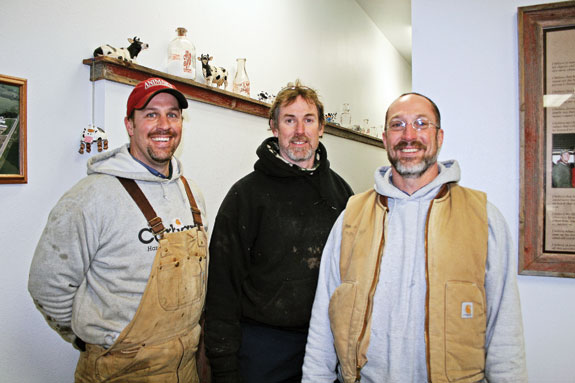to jump to the article. Summary: In this March 1st feature, Progressive Dairyman Editor Karen Lee described the efforts of Paul, Steve and Joe Fetzer to increase cow comfort on their 800-cow dairy. The brothers installed a new eight-row, cross-ventilated freestall barn in 2008 and have since seen an average milk production of 85 pounds per day. Because this article was so popular, we asked Paul Fetzer a follow-up question: Q: What have you done in the past year to increase cow comfort on your dairy? A: We completed the remodel of our transition barn from mattresses to sand. The conversion allowed us to tear out all of the old stall decks and curbs. We increased stall length by 6 inches by pouring new curbs and deep-bedded with sand. This has greatly increased the comfort and traction for close-up and post-fresh animals.
We believe that the combination of sand bedding and positive air flow with our cross-vent and tunnel-ventilated buildings has led to greater cow comfort and productivity.
—Paul Fetzer, dairy producer, Wisconsin
[Click here or on the image above right to see the full list of the Top 25 articles of 2011. Click here to see the list from 2010.]
ARTICLE

Fetzer Farms Inc. is a 1,500-cow dairy with 1,800 acres in Elmwood, Wisconsin.
Brothers Paul, Steve and Joe Fetzer continue the tradition of their family business passed on from their grandfather, father and uncle. Their mother, Betsy, continues to be very active in the farm’s daily operations, as well.
In the fall of 2008, they moved 800 cows into a new eight-row, cross-ventilated freestall barn. These cows are milked three times a day in a double-20 parallel parlor.
The added cow comfort has the cows averaging 85 pounds of milk per day with a 3.99 fat and 3.25 protein. rBST is used on 50 percent of the herd, based on production and reproduction records.
The cross-ventilated barn has curtains for baffles instead of steel. It also has a double curtain fogger sidewall instead of the evaporative cooling pad, which is seen more often in this type of facility. The Fetzers believe the curtains allow for more translucent light to enter the barn.
“The cows are comfortable. The employees are comfortable,” Paul said.
He also noted the incidences of pneumonia have been lower in this facility than what they experienced in their old conventional one.
The Fetzers had a less than 10 percent overrun on the cost of their new building. “We knew what we wanted and stuck with it,” Paul said. “We did our research before construction began.”
Far-off dry cows are also housed in the cross-ventilated barn. Close-up dry cows are moved to the maternity barn, where they freshen. Those cows are milked there for one to two weeks before returning to the main milking string. The Fetzers keep all cows in one pen together throughout their entire lactation.
As part of the construction, they also converted an older freestall barn to tunnel ventilation and sand bedding. The barn holds 400 first-calf heifers and is connected to the new parlor.
Sand-laden manure from that barn and the cross-ventilated one are automatically scraped to a center collection pit in a sand separation room.
The raw manure is diluted with CIP water collected in a separate tank. It is pumped into the sand separator where it is washed with fresh water. Once heavy sand is removed, the effluent flows down a small separating lane to remove the fine sand particles.
Rotary screens filter the water, which is recycled back to the separation process and used to flush the holding area. Solids are pumped to a lagoon for storage.
Sand reclaimed from the manure sits in this room for two to three weeks to let the wash water leach out before being reintroduced to the stalls, which are bedded once a week.
“We haven’t purchased any new sand since January,” Paul mentioned during a December tour.
Previously the beds were made with mattresses and sawdust, which still remains in the springing heifer and maternity barn. The Fetzers are in the process of converting that barn to sand, too.
“We found once the girls get used to sand, they won’t lie down on anything else,” he said.
Sand bedding and better climate control has made a difference in the dairy’s milk quality. When they moved into the new facility, somatic cell counts were around 270,000 to 280,000.
That was reduced to 132,000, but after a spike from high humidity this summer, they are working again to get down to that level. In December, the farm was averaging 139,000.
RFID tags are used to track the cows’ progress in the parlor and they are wand-read in the freestalls to record reproduction and herd health occurrences.
Cropping had been a part of Fetzers’ operation until they partnered with a neighboring dairy to form a separate LLC. This entity owns the equipment needed to cover the combined 3,500 acres of forage and all fall manure applications.
In order to be more efficient on the operation, a number of years ago the Fetzers took time to measure shrink in their feeding system.
They determined that if they switched to storing ground corn, a vitamin/mineral mix, soybean meal and dried distillers grains in bins on the dairy, they could reduce their feed loss in this area by 65 tons a year.
Calves from the farm are picked up every week and sent to a nearby grower. When they reach 400 pounds they are transferred to a second grower before returning to the farm pre-fresh.
The Fetzers have worked to make cows their main focus and it is evident from the facilities to their management style. PD

-
Karen Lee
- Midwest Editor
- Email Karen Lee







